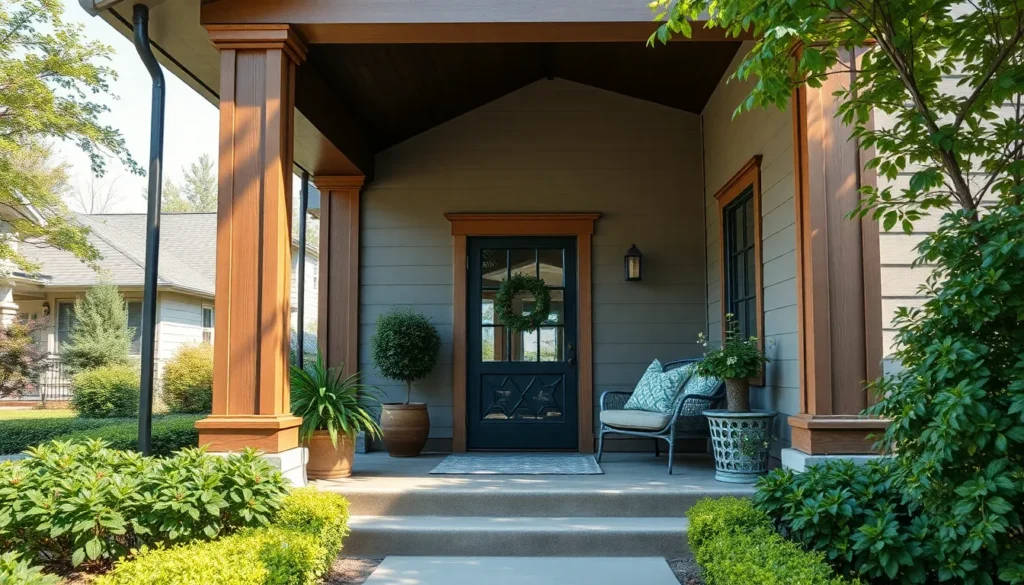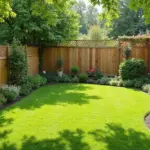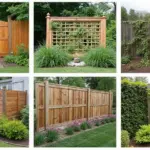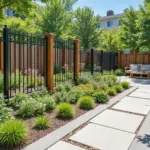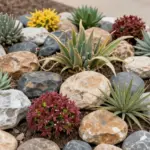We’ve all walked past homes that make us stop and stare – and more often than not it’s those stunning front porch columns that catch our eye first. These architectural elements don’t just hold up your roof; they’re the difference between a house that blends in and one that commands attention from every passerby.
Whether you’re building from scratch or ready to transform your existing porch we know choosing the right column style can feel overwhelming. From classic Greek Revival to modern minimalist designs the options seem endless. That’s exactly why we’ve curated the most inspiring front porch column ideas that’ll elevate your home’s curb appeal instantly.
Ready to turn your ordinary entrance into a showstopper? We’re about to walk you through proven column designs that not only boost your property value but create that welcoming first impression every homeowner dreams of achieving.
Classic Wooden Column Designs for Timeless Appeal
Classic wooden columns remain the gold standard for front porch design, offering enduring beauty that never goes out of style. These natural elements create warmth and character that synthetic materials simply can’t match.
Traditional Turned Wood Columns
Traditional turned wood columns showcase intricate craftsmanship through their distinctive curved profiles and decorative details. We see these elegant columns featuring bulbous sections, fluted surfaces, and ornate capitals that create visual interest from every angle. Victorian and Georgian style homes particularly benefit from these elaborate designs, which often include hand carved rosettes, egg and dart moldings, and acanthus leaf patterns.
These columns typically range from 8 to 12 inches in diameter and can support substantial roof loads while maintaining their decorative appeal. Popular wood choices include cedar, redwood, and pressure treated pine, with cedar offering natural weather resistance and beautiful grain patterns. Many homeowners choose to paint these columns in classic white or cream colors to highlight the detailed turning work and create striking contrast against darker siding materials.
Square Craftsman Style Posts
Square Craftsman style posts deliver clean lines and geometric simplicity that define the Arts and Crafts movement aesthetic. We love how these posts feature thick, substantial proportions typically measuring 8×8 or 10×10 inches, creating a sense of strength and permanence. The posts often include decorative brackets, beveled edges, and recessed panels that add subtle visual texture without overwhelming the overall design.
These versatile columns work exceptionally well with bungalow homes, ranch houses, and contemporary farmhouse designs. Wood species like Douglas fir, oak, and mahogany provide excellent structural integrity and beautiful natural grain patterns. The posts can be stained to showcase the wood’s natural beauty or painted in earth tones like sage green, warm gray, or deep brown to complement the Craftsman color palette.
Tapered Colonial Columns
Tapered Colonial columns offer refined elegance through their gradually narrowing profile that creates visual lightness and sophisticated proportions. We find these columns particularly effective on Federal, Greek Revival, and Neocolonial homes where they enhance the formal architectural character. The taper typically begins at the one third point and reduces the diameter by 1 to 2 inches from base to top, creating pleasing visual movement.
These columns commonly feature smooth surfaces with minimal ornamentation, allowing the graceful taper to serve as the primary decorative element. Standard sizes range from 10 to 16 inches at the base, with heights extending from 8 to 12 feet depending on the porch scale. Popular finishing options include classic white paint, natural wood stain, or historically appropriate colors like Williamsburg blue or Charleston green that complement traditional Colonial architecture.
Modern Minimalist Column Options
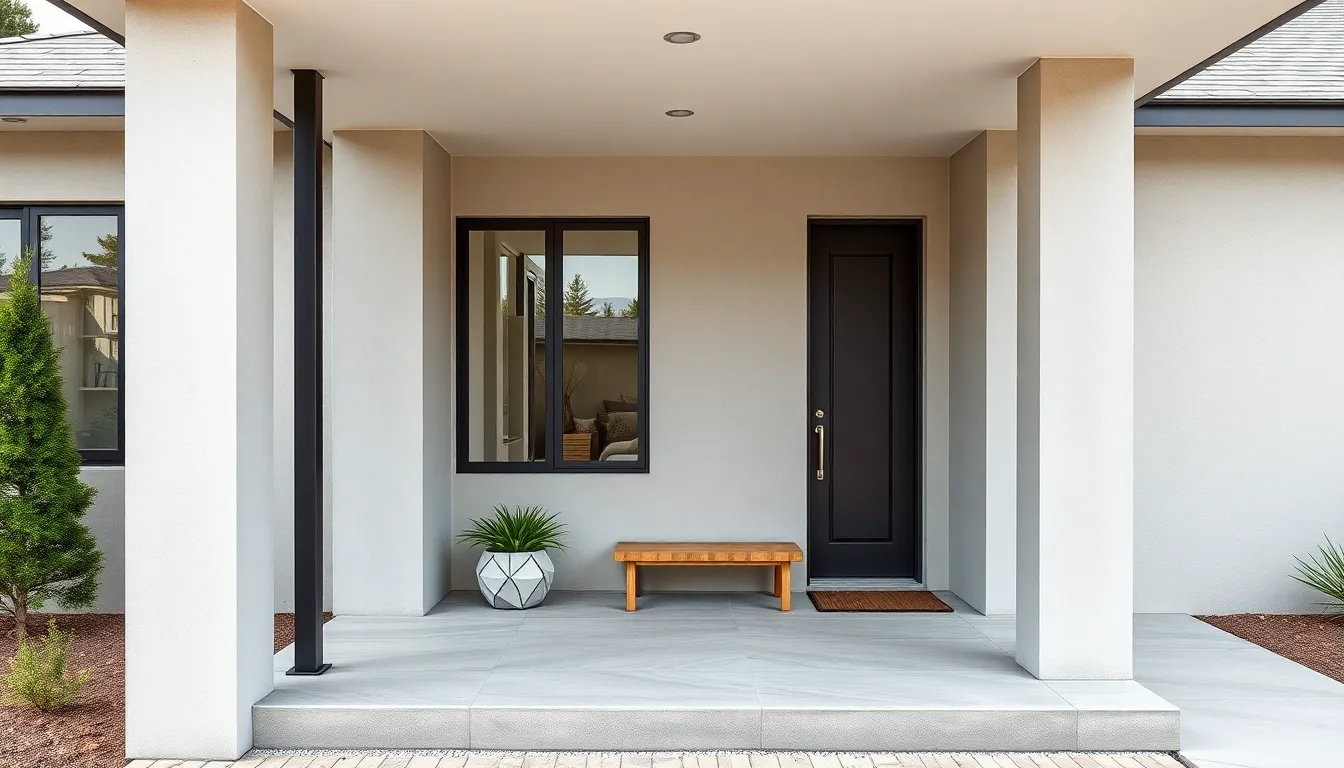
We’re seeing more homeowners embrace clean, uncluttered designs that emphasize simplicity and architectural precision. Modern minimalist columns strip away decorative elements to focus on pure form and function.
Sleek Steel Posts
Steel posts deliver bold contemporary appeal with their smooth, slender profiles and sophisticated dark finishes like black or gunmetal. We love how these columns create an industrial elegance that makes porches feel open and uncluttered while adding a striking modern edge. Their durability means they’ll maintain that crisp appearance for years without the maintenance requirements of other materials.
Minimalist decor pairs perfectly with steel posts. Simple benches and geometric planters maintain the streamlined aesthetic without creating visual competition. The slim form factor allows maximum visibility while providing essential structural support.
Clean-Lined Concrete Columns
Concrete columns bring substantial modern sophistication through their uniform, geometric shapes and monochromatic palette. We find that squared or rectangular concrete posts work exceptionally well in grays or whites that complement minimalist design themes. Their smooth or lightly textured surfaces provide structural prominence without overwhelming the overall aesthetic.
These columns project strength while maintaining the understated elegance that defines minimalist architecture. Homeowners appreciate how concrete’s substantial appearance creates visual weight that anchors the porch design beautifully.
Simple Square Wood Posts
Wood posts in minimalist style feature square or rectangular profiles with straight edges and zero ornamentation. We recommend natural wood tones or painted finishes in neutral colors to preserve the design’s inherent simplicity. Slim wooden columns add warmth and subtle rustic charm while keeping the look clean and uncluttered.
Their organic texture creates gentle contrast with sleek modern materials, offering visual interest without complexity. Square wood posts prove that minimalist doesn’t mean cold – they bring natural warmth that makes modern porches feel welcoming and sophisticated.
Stone and Brick Column Ideas for Durability
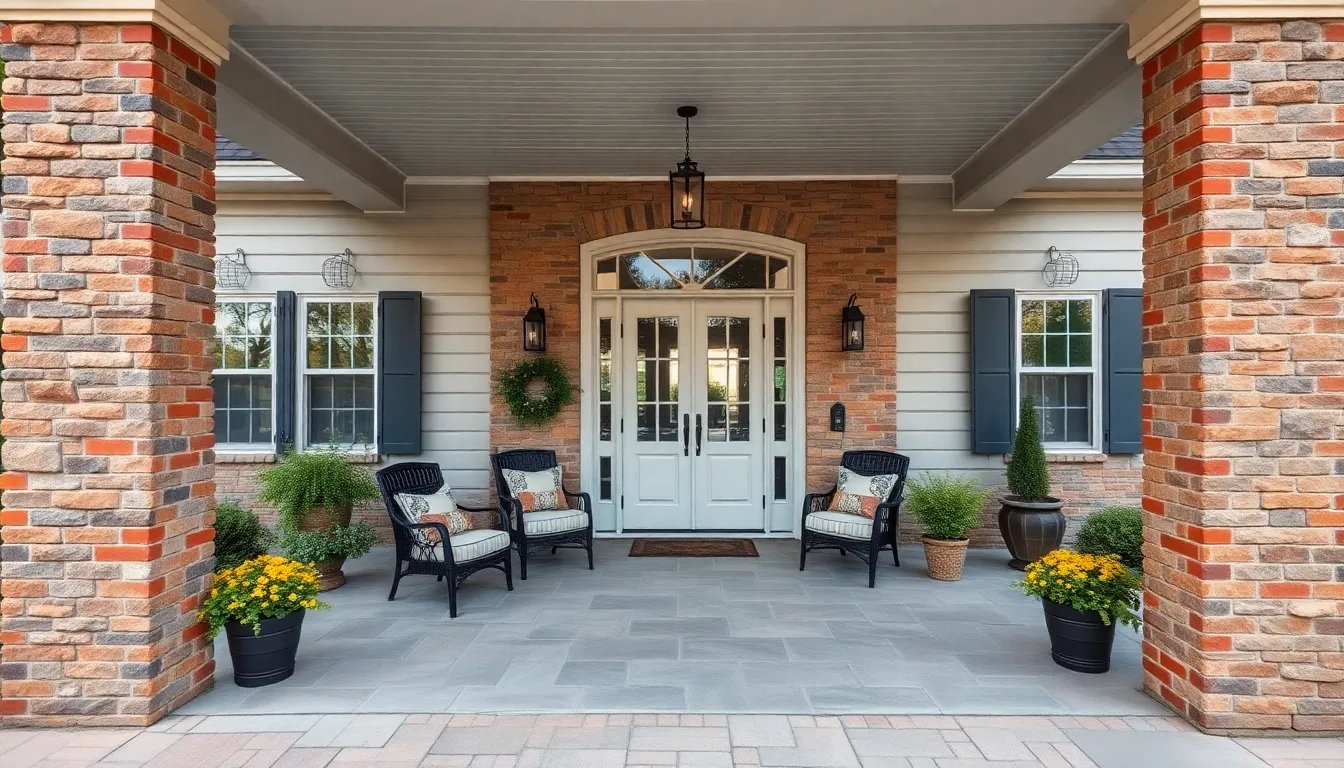
Stone and brick columns represent the pinnacle of durability and timeless appeal for front porch design. These materials offer unmatched longevity while creating a sophisticated foundation that enhances your home’s architectural character.
Natural Stone Pillars
Natural stone pillars bring both elegance and exceptional strength to your front porch design. Granite, limestone, and sandstone options provide robust support that withstands weather conditions and the test of time better than most alternatives. These columns showcase rough, textured surfaces that perfectly complement rustic and traditional home styles.
You can construct natural stone pillars as full solid columns for maximum durability and visual impact. Alternatively, we recommend using them as bases topped with wood or metal posts to create stunning mixed material designs. Natural color variations in stone add unique character that makes each pillar distinctive and appealing.
Premium natural stone options require minimal maintenance while delivering decades of reliable performance. Stone pillars resist fire, moisture, and temperature fluctuations that often damage other column materials. Their substantial appearance creates an impressive entrance that significantly boosts curb appeal and property value.
Brick Column Designs
Brick columns offer classic, sturdy answers that beautifully complement craftsman, colonial, and farmhouse architectural styles. Various laying patterns like running bond and Flemish bond add visual interest and showcase skilled craftsmanship. These versatile columns age gracefully and often become more charming with time.
Full brick columns serve as excellent load bearing supports for covered porches and heavy roof structures. Brick bases capped with wooden or stone posts create attractive two tone designs that blend traditional and contemporary elements. Contrasting mortar colors and decorative brickwork patterns enhance curb appeal and create personalized style statements.
Fire resistant properties make brick columns exceptionally safe and durable for long term use. Low maintenance requirements mean you’ll spend less time on upkeep and more time enjoying your beautiful porch. Matching brick columns with brick front steps or pathways creates cohesive exterior designs that tie your industry elements together seamlessly.
Stacked Stone Columns
Stacked stone columns use thin slices of natural stone adhered to structural cores, delivering solid stone aesthetics at lower cost and weight. These columns can be crafted in different shapes and heights to match your exact design requirements. Textured, layered appearances provide highly decorative elements that enhance modern, rustic, and transitional home styles.
Installation as bases on wooden posts creates unique mixed material combinations that stand out from traditional column designs. Full stacked stone columns offer complete natural stone coverage for homeowners who prefer uniform materials throughout their porch structure. Natural, earthy aesthetics combine beautifully with proven durability and relatively easy installation processes.
Stacked stone resists weathering significantly better than wood alternatives while requiring less frequent maintenance than many other materials. These columns provide excellent value by offering premium stone appearance without the expense of solid stone construction. Various stone types and color combinations allow customization that perfectly matches your existing home exterior and industry design.
Decorative Metal Column Styles
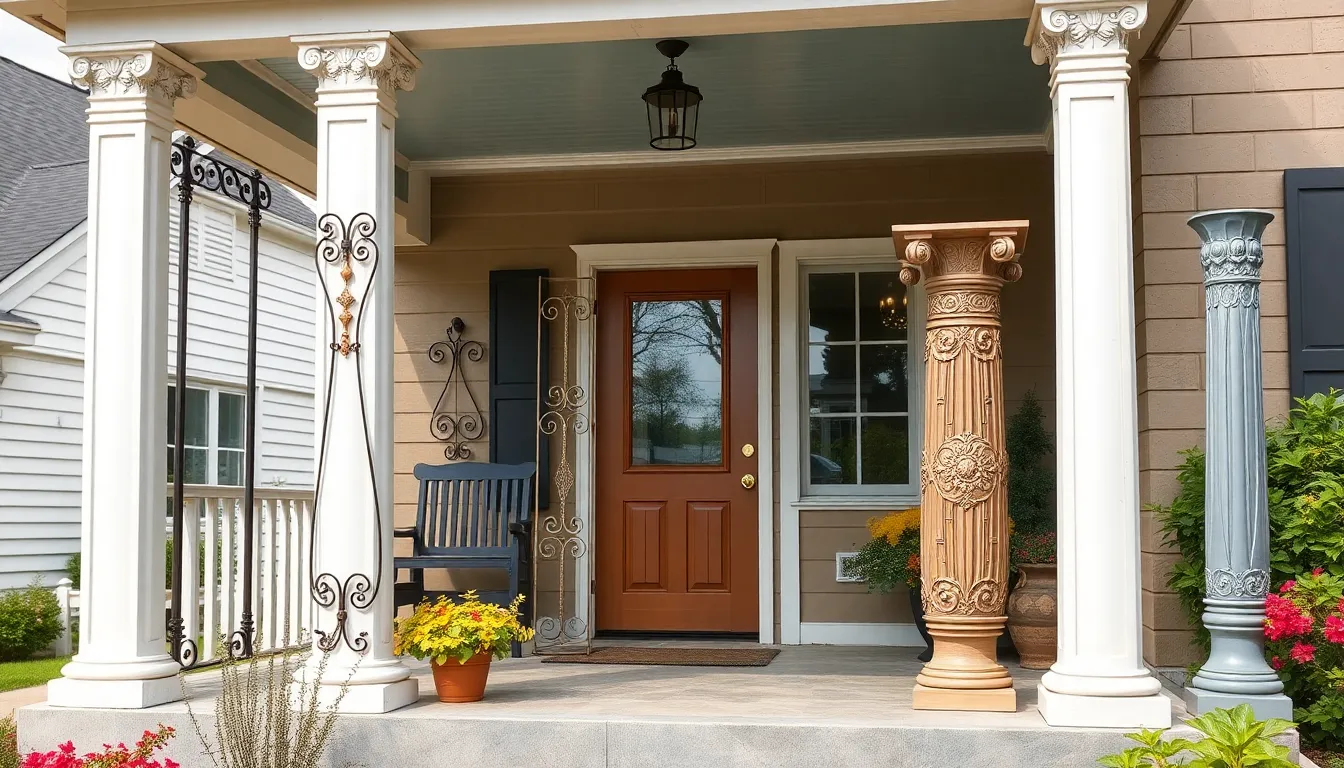
Metal columns offer exceptional durability while creating distinctive architectural statements that complement both traditional and contemporary porch designs. These versatile options provide superior weather resistance compared to wood while delivering unique aesthetic appeals that can transform your front entrance.
Wrought Iron Columns
Wrought iron columns showcase elegant craftsmanship through their intricate scrollwork and ornamental patterns that create timeless visual appeal. These columns enhance historic homes and Victorian style properties with their vintage charm and sophisticated detailing. Weather resistant properties make wrought iron an excellent long term investment, though occasional maintenance prevents rust formation. Decorative elements like twisted spirals, leaf motifs, and geometric patterns allow customization to match your home’s architectural character.
Cast Iron Victorian Posts
Cast iron posts deliver the elaborate detailing that defines Victorian era architecture through features like fluting, floral motifs, and decorative capitals. These sturdy columns provide exceptional load bearing capacity while creating stately, ornate appearances that command attention. Painting options allow you to match your house’s color scheme while the material withstands outdoor elements exceptionally well. Important weight and presence make cast iron ideal for large porches requiring strong structural support with maximum visual impact.
Aluminum Column Options
Aluminum columns provide lightweight, cost effective alternatives to traditional iron while requiring minimal maintenance throughout their lifespan. Manufacturing processes allow molding into various profiles including classical round designs and contemporary square styles that suit modern preferences. Rust and corrosion resistance makes aluminum suitable for all climate conditions without deteriorating over time. Factory finished options come in many colors while the material works perfectly for transitional porch designs that blend traditional and modern elements.
Mixed Material Column Combinations
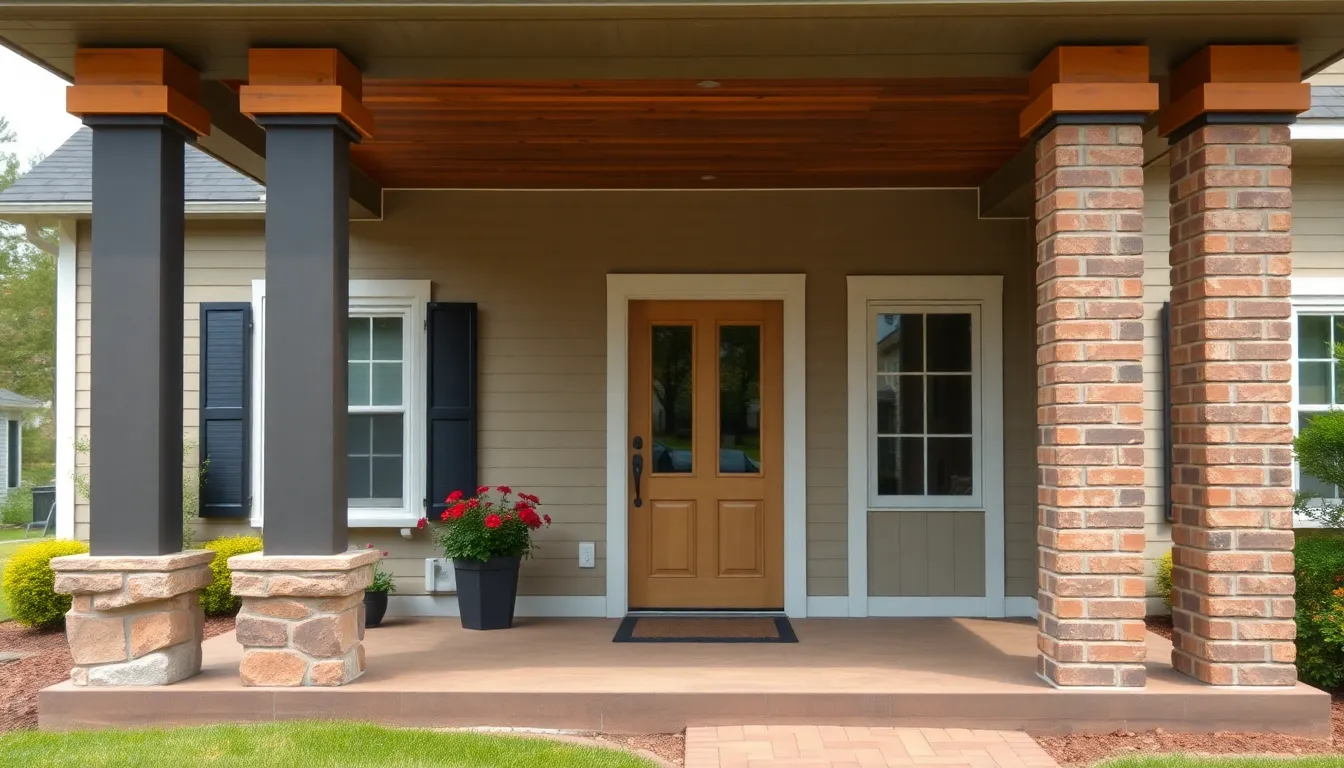
Combining different materials in column construction creates visually striking porch supports that maximize both durability and aesthetic appeal. We’ve found these hybrid approaches offer superior weather resistance while delivering unique architectural character.
Stone Base with Wood Top
Stone foundation columns topped with wooden upper sections deliver the perfect balance of strength and warmth for front porch designs. We recommend this popular combination because the masonry base provides excellent weather resistance near ground level while the wood component adds natural texture and customization options. Craftsman and rustic style homes particularly benefit from this earthy material pairing that grounds the structure visually.
Painting or staining the wooden upper portion allows us to complement any exterior color scheme while maintaining the stone’s natural beauty. The stone base protects against moisture damage and ground contact issues that plague all wood columns. This combination works exceptionally well for homes seeking that blend of rugged durability with inviting warmth.
Metal and Wood Hybrid Designs
Steel or iron columns paired with wooden accents create contemporary porch supports that balance industrial strength with natural warmth. We’ve seen this hybrid approach gain popularity in modern farmhouse and transitional home designs where structural integrity meets aesthetic flexibility. The metal framework allows for slimmer column profiles while providing superior load bearing capacity.
Wooden elements soften the industrial appearance of raw metal and offer endless customization through paint colors and stain finishes. These combinations work particularly well when we want to maintain clean lines while adding organic texture. The metal component ensures long term durability with minimal maintenance requirements compared to traditional all wood options.
Brick with Decorative Caps
Brick columns crowned with decorative caps provide classic porch support with enhanced architectural interest and weather protection. We typically see stone, concrete, or wood caps used to finish these solid brick structures while protecting the masonry from water damage. Traditional, colonial, and historic home styles especially benefit from this elegant finishing approach.
Molded or carved caps add sophisticated detail that elevates basic brick construction into statement architectural features. The brick provides fire resistance and requires minimal maintenance while the decorative cap creates visual weight and finished appearance. This combination delivers the durability homeowners expect with the refined aesthetics that increase property value.
Budget-Friendly DIY Column Solutions
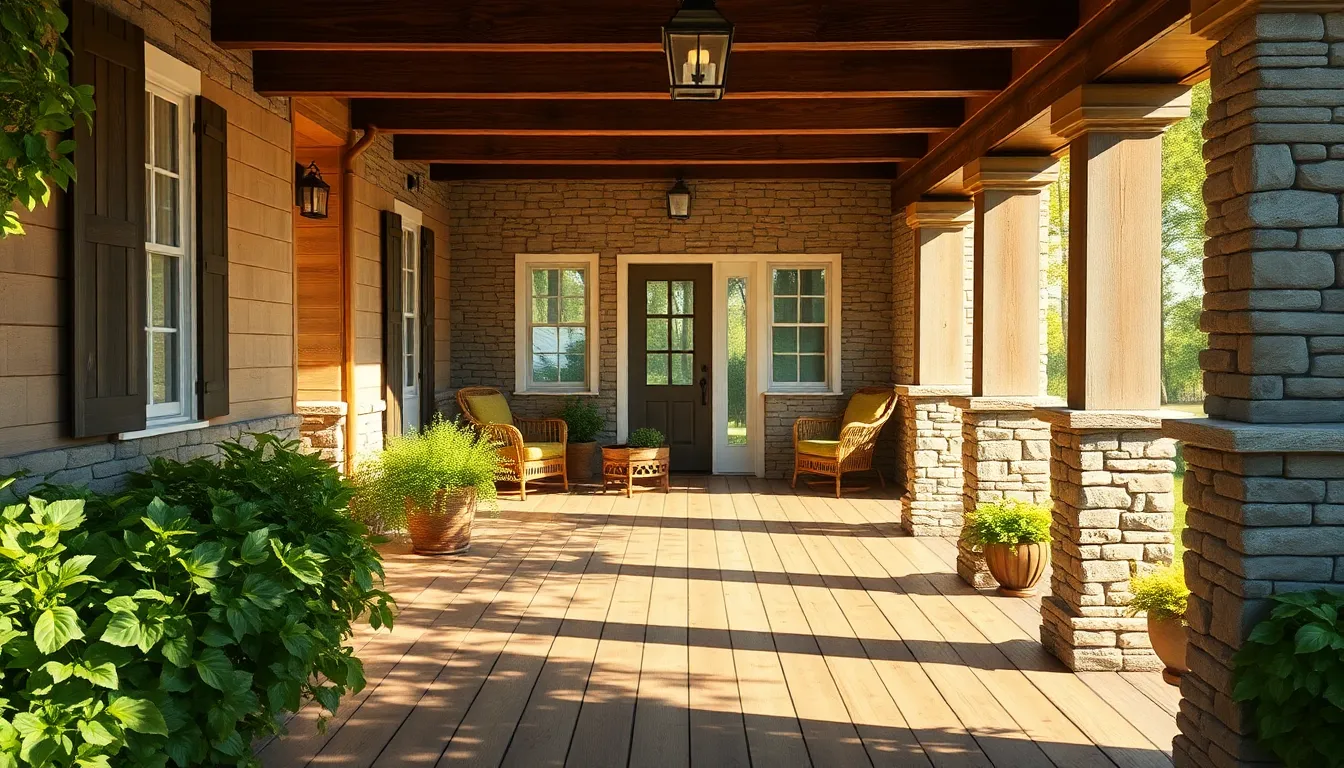
We’ve explored premium column options, but transforming your front porch doesn’t require very costly. These affordable DIY answers deliver impressive results while keeping costs manageable.
PVC Wrapped Columns
PVC wrapped columns offer one of the most cost-effective ways to upgrade your existing porch posts without major construction. We love how this weather-resistant material requires minimal maintenance while delivering a clean, polished appearance that complements any architectural style.
Installation Process:
- Attach spacer boards around your existing post for proper fitting
- Cut PVC boards or panels to match your porch height
- Secure the PVC pieces to form a box-like column shape
- Add decorative trim at the top, bottom, and middle sections
Key Benefits:
- Easy to cut and customize for different post sizes
- Can be painted to match your home’s exterior color scheme
- Transforms worn or plain posts into attractive architectural features
- Resists weather damage and maintains its appearance over time
Reclaimed Wood Posts
Reclaimed wood creates stunning rustic columns while supporting eco-friendly building practices and reducing material costs. We find this option particularly appealing for homeowners seeking authentic character and warmth in their porch design.
Construction Techniques:
- Cut 1×6 and 1×8 boards to your porch height for proper proportions
- Assemble boards into a box configuration using clamps for alignment
- Secure pieces with wood glue and finishing nails for durability
- Apply stain or paint to enhance the natural wood grain
Design Advantages:
- Delivers authentic Craftsman style appeal with geometric simplicity
- Provides unique texture and character that new lumber cannot match
- Offers flexibility in finishing options from natural stains to bold paint colors
- Creates substantial visual impact while remaining budget conscious
Faux Stone Column Covers
Faux stone column covers deliver the sophisticated look of natural stone at a fraction of the cost and installation complexity. We recommend these slip-on sleeves for homeowners wanting dramatic curb appeal without the weight and expense of real masonry.
Material Options:
- Molded concrete covers that mimic granite and limestone textures
- Composite materials designed to replicate natural stone patterns
- Lightweight construction that won’t stress existing porch structures
- Factory-finished surfaces that require no additional treatment
- Slip directly over existing posts for quick transformation
- No specialized masonry skills or tools required
- Important weight reduction compared to solid stone construction
- Enhanced curb appeal with classic stone aesthetics at affordable prices
Size and Proportion Guidelines for Porch Columns

Getting the proportions right transforms your porch from ordinary to extraordinary. We’ll guide you through the essential measurements that create visual harmony between your columns and home.
Choosing the Right Column Height
Column height depends primarily on the vertical distance from your porch floor to the ceiling or roofline. Traditional homes typically feature columns extending from the porch floor to roof, usually ranging from 8 to 10 feet tall. Shorter columns work perfectly when your porch ceiling sits lower or when design elements like porch walls reduce the need for multiple tall columns.
We recommend measuring carefully before ordering, as ceiling height determines your column requirements. Standard residential porches accommodate 8-foot columns comfortably, while grander homes often require 9 to 10-foot options. Consider your home’s scale when selecting height, ensuring columns don’t appear dwarfed by a large structure or overwhelming on a modest cottage.
Determining Proper Column Width
Column width should complement both height and porch style for optimal visual balance. We suggest sizing columns so their width equals roughly one-tenth to one-twelfth of their height for proper proportions. A 9-foot tall column, for example, should measure 9 to 10 inches wide if you choose a square design.
Wrapping or customizing posts allows you to increase thickness, creating a more substantial and sturdy appearance. This approach works especially well when your porch features fewer columns, as thicker posts provide better visual weight distribution. Material choice affects width considerations too, with wood offering rustic or farmhouse appeal, steel providing modern lines, and classical columns following Greek Revival proportions with elaborate detailing.
Spacing Considerations
Spacing columns correctly ensures both structural integrity and aesthetic flow across your porch design. We typically guide spacing based on your porch roof span and local building code requirements for safety. Evenly spaced columns create visual rhythm and architectural balance that enhances your home’s curb appeal.
Porches with an exterior wall on one side often need just a single column on the open side, since perfect symmetry becomes less critical in this configuration. Multiple column installations, such as the eight columns common in Greek Revival porches, benefit from consistent spacing aligned with windows or doors for visual cohesion. We recommend consulting structural engineers for spans exceeding standard distances to ensure proper support while maintaining your desired aesthetic.
Installation and Maintenance Tips
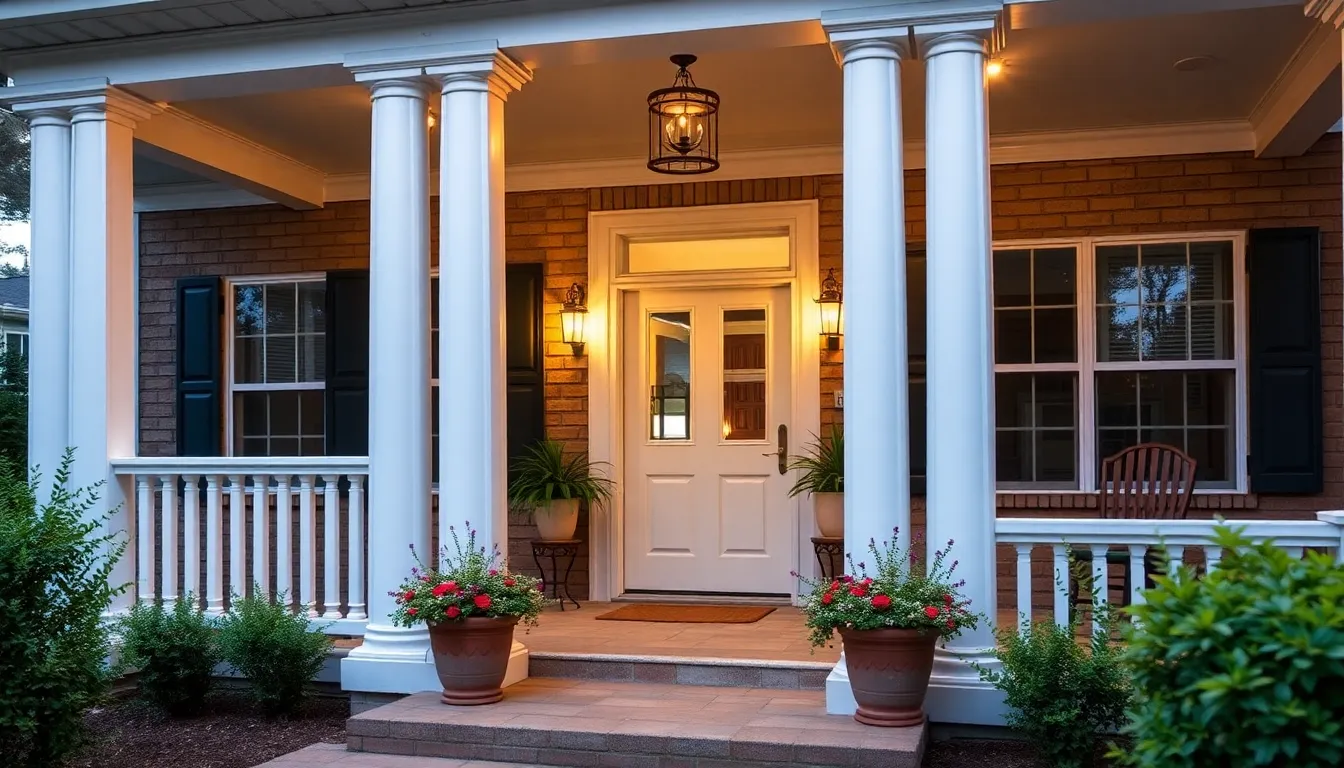
Once you’ve selected the perfect columns for your front porch, proper installation and ongoing maintenance become crucial for long-term success. We’ll guide you through the key decisions and practices that’ll keep your columns looking great and structurally sound for years to come.
Professional vs. DIY Installation
Professional installation offers the highest level of structural integrity, especially in regions prone to harsh weather conditions. Licensed contractors use code-approved methods for anchoring posts and finishing work, which minimizes the risk of future damage to your porch structure. They’ll ensure proper preparation by cleaning column surfaces with compatible cleaners and sanding with 120-grit or finer wet/dry sandpaper before applying finishes.
DIY installation remains possible with the right tools and careful attention to installation guidelines. You’ll need to focus on anchoring structural posts first to the floor using code-approved post anchors, then securing the base and cap with screws after drilling pilot holes. For PVC columns, we recommend sliding column halves together tightly, fastening with staples or finish nails every 6-8 inches, and applying construction adhesive between surfaces for added strength. Sealing becomes critical in DIY projects—apply caulk to all gaps between the column shaft and both the base and cap to prevent moisture penetration.
Weatherproofing Your Columns
Exterior-grade paints and primers provide the foundation for weather resistance on all column materials. We recommend using one coat of 100% acrylic exterior primer followed by two coats of acrylic latex paint for maximum durability and weather protection. Always wipe off dust before painting to ensure proper adhesion.
High-quality caulk blocks moisture entry when applied to all joints and gaps around your columns. This step proves especially important for preventing water damage that can compromise both appearance and structural integrity.
Wood columns require periodic sealing or repainting to prevent rot and maintain their protective coating. Regular maintenance every few years helps preserve the natural beauty while extending the column’s lifespan.
PVC columns offer inherent weather resistance but still need proper sealing and paint finishes for both aesthetics and protection. Their low maintenance requirements make them an excellent choice for busy homeowners.
Long-Term Care and Upkeep
Regular cleaning with mild detergent and water removes dirt, pollen, and debris that can accumulate on column surfaces. Avoid harsh chemicals that can damage protective finishes and compromise the material underneath.
Periodic inspections help you catch problems early before they become costly repairs. Look for cracks, peeling paint, or caulk failure and perform touch-ups promptly to maintain your columns’ protective barrier.
Repainting schedules should follow manufacturer recommendations, typically every few years or as needed to maintain the protective coating. Acrylic latex paint provides excellent durability for most column materials.
Structural connection checks ensure your columns remain stable and safe, especially after severe weather events. Inspect all mounting points and fasteners to verify they’re still secure and functioning properly.
Conclusion
We’ve explored an impressive range of front porch column options that can transform your home’s entrance into a stunning focal point. From timeless wooden designs to sleek modern materials each style offers unique benefits for different architectural preferences and budgets.
The key to success lies in matching your column choice to your home’s existing style while considering practical factors like maintenance requirements and local climate conditions. Whether you’re drawn to the elegance of natural stone the warmth of reclaimed wood or the durability of metal options there’s a perfect solution waiting for your porch.
Remember that proper sizing installation and ongoing maintenance are just as important as selecting the right material. With careful planning and attention to detail your new porch columns will enhance your home’s curb appeal for years to come.
Frequently Asked Questions
What are the most popular front porch column styles?
The most popular front porch column styles include classic wooden columns (turned, square Craftsman, and tapered Colonial), modern minimalist designs (steel, concrete, and simple square wood), stone and brick columns, decorative metal options (wrought iron, cast iron, aluminum), and mixed material combinations. Each style complements different architectural designs and offers unique aesthetic and structural benefits.
How do I choose the right column size for my porch?
Column height should match the vertical distance from porch floor to ceiling, typically 8-10 feet for traditional homes. Width should be roughly one-tenth to one-twelfth of the height for proper proportion. Ensure even spacing between columns based on your porch design and local building codes for both structural integrity and visual appeal.
What are the most budget-friendly column options?
Budget-friendly options include PVC wrapped columns, reclaimed wood posts, and faux stone column covers. PVC wrapping existing posts is cost-effective and weather-resistant. Reclaimed wood offers rustic charm at lower costs. Faux stone covers provide the sophisticated look of natural stone without the expense or weight of real masonry.
Do porch columns require professional installation?
While professional installation ensures structural integrity and code compliance, DIY installation is possible with careful planning. Professional installation is recommended for load-bearing columns or complex designs. DIY projects work well for decorative column covers or simple replacements, but always check local building codes and permit requirements first.
How do I maintain my porch columns?
Regular maintenance includes cleaning, inspection, and weatherproofing. Use exterior-grade paints and caulks to protect against moisture. Clean columns seasonally, inspect for damage or wear, and repaint as needed. Wood columns may require more frequent maintenance than metal or PVC options. Proper sealing prevents moisture penetration and extends column life.
Can I mix different column materials?
Yes, mixed material combinations are popular and effective. Common combinations include stone bases with wood tops, metal and wood hybrids, and brick columns with decorative caps. These combinations balance durability with aesthetic appeal, offering the strength of one material with the warmth or visual interest of another while enhancing overall curb appeal.

